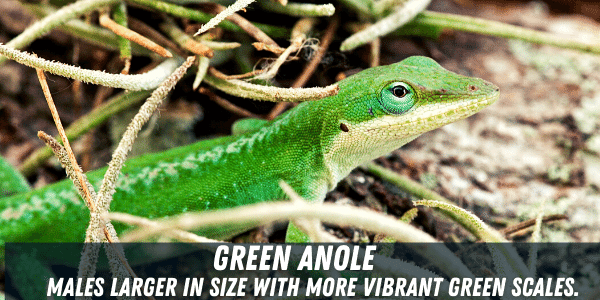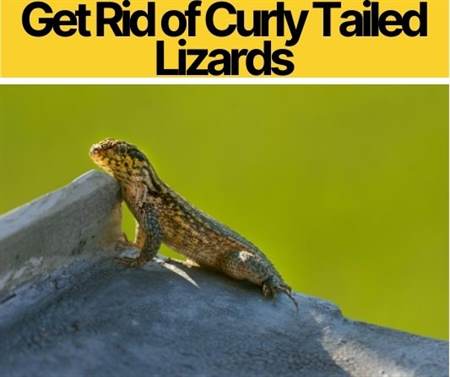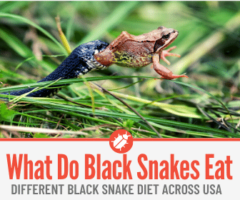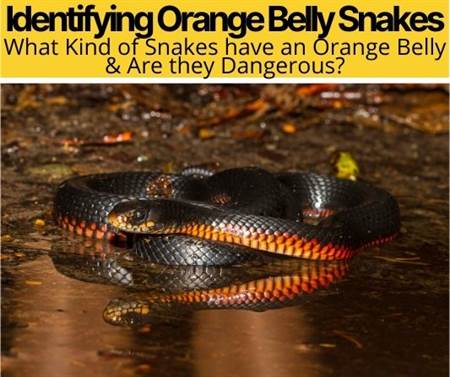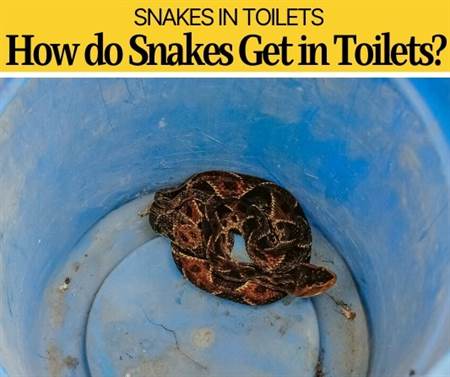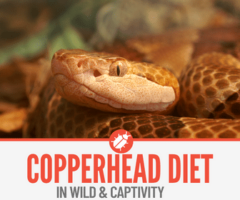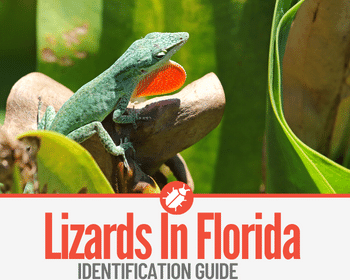 Wondering What kind of Lizards are living in Florida? Perhaps you are trying to figure out what is that lizard you saw while visiting Florida?
Wondering What kind of Lizards are living in Florida? Perhaps you are trying to figure out what is that lizard you saw while visiting Florida?
In this guide we will cover:
- The most common lizards found in Florida,
- How to identify the different lizards & Where To find them in Florida,
- What the lizards like to eat in Florida & How to Get Rid of them.
Florida has one of the most diverse ecosystems with a variety of wildlife and is home to more than 50+ Different Lizards.
Most Common Florida Lizards
Below is a list of 17 of the most common lizards found in Florida:
- Green Anole
- Coal Skink
- Chameleon
- Six-Lined Racerunner
- Florida Scrub Lizard
- Eastern Glass Lizard
- Florida Sand Skink
- Eastern Fence Lizard
- Nile Monitor
- Green Iguana
- Spiney-Tailed Iguana
- Giant Argentine Tegu
- Ground Skink
- Slender Glass Lizard
- Mimic Glass Lizard
- Broadhead Skink
- Island Glass Lizard
Green Anole
The green anole comes in a variety of shades of green, hence their name. They can also comes in shades of brown depending on certain environmental conditions. You can easily tell a male and a female apart by examining their size and color differences.
A male green anole will be larger in size, around 8 inches, and their scales will be a more vibrant green.
A female will be smaller, around 5 inches instead, and they will normally have a duller green color to them, similar to a forest green.
This lizard in Florida can mostly be found scurrying around in the daytime and basking in the sunshine to get warm. You’ll see it suddenly scurry away to fend off other reptiles or to catch a bug for a quick meal before returning back to basking.
Where To Find The Green Anole
This little, green anole lizard is a species that is native to Florida and they can be found all throughout the southern state as well as many of the other southeastern states.
Normally, you will be able to easily find green anoles in most suburban areas and occasionally you’ll see them on your fences or rooftops.
In the wild in Florida they will normally barely get past two years old, while those that live in captivity can live up to 7 years.
What Does The Green Anole Eat In Florida
The green anole in Florida will most commonly feast on a variety of insects ranging from protein-rich crickets to mealworms, which are just as nutritious.
Green anoles are also known to be nectar drinkers, which means that they like to eat small pieces of fruit when they can get some.
In captivity, they will even eat food puree, or baby food.
Coal Skink
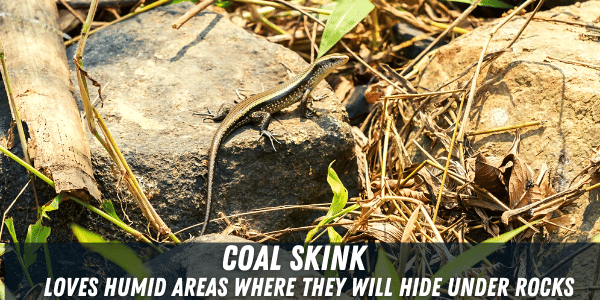
The coal skink is a small, shiny looking skink that will usually have a grey or brown color to them with a dull blue colored tail. A male coal skink will usually measure to be 5 or 6 inches in length, while a female kink will tend to grow longer.
Where To Find The Coal Skink In Florida
This species can be found throughout the eastern United States, but it can also be found around the Florida Panhandle.
These lizards aren’t easy to find since they are uncommon in this part of Florida. Although, like many other reptiles, the coal skink particularly enjoys hot and humid climates.
They also love humid areas around moving bodies of water. There, they will hide under rocks and other vegetation or debris. If they feel threatened, they will retreat into the water to hide.
What Does The Coal Skink Eat In Florida
Coal skinks in Florida live off of an insect diet that relies mostly on spider, crickets, caterpillars, and grasshoppers, all depending on the sizes of them.
All species of skink are non-venomous and they are completely harmless to humans. If you happen to find one in your house, simply catch it gently with your hands and place it in a box before releasing it back into the wild.
Make sure to not keep the coal skink in their temporary home for more than 12 hours!
Chameleon
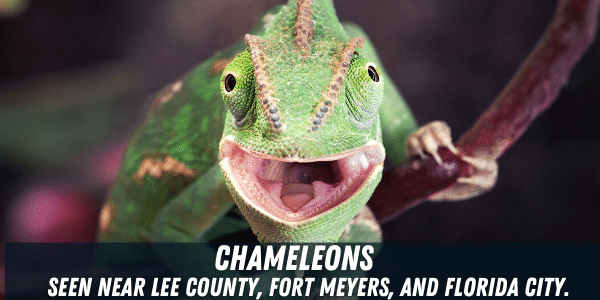
The chameleon is an incredibly unique reptile since it is able to change into a variety of beautiful colors for the sake of camouflage. Normally, im Florida you will find them to be more of a green color and it will have a long tail that stays curled.
On either side of its head are a pair of bulging eyes. They are able to move each eye independently, and while it may look strange to us, it is incredibly useful for their survival.
You can easily tell a female and a male apart by looking at their size differences. A male can grow up to 18 inches, and around 24 inches at the very biggest.
A female will grow, at the biggest, to around 12 inches. Sometimes they will come smaller than that.
Where To Find The Chameleon In Florida
The chameleon is actually native to Madagascar, Africa, southern Asia, and southern Europe.
They were brought to the states for the purpose of them becoming pets, and now there are six known species of chameleons in Florida because they either escaped their enclosure or they were released by their owners.
These reptiles are tree-dwellers, so in Florida you will almost always find them high up in the trees if you are ever looking for them. Some species of chameleon have been found reproducing near areas around Lee County, Fort Meyers, and Florida City.
They can also live in a variety of habitats such as shrublands, forests, and savannas.
What Do Chameleons Eat in Florida
Like other lizards, chameleons love to feast on large bugs that they find. Their favorites are normally larger insects like locusts, stick bugs, praying mantises, and crickets.
Larger chameleons in Florida will go as far as to devour small birds and lizards if they happen to be the right size. Some chameleons will eat on plants like collared or mustard greens, but it’s not exactly their favorite meal most days.
Six-Lined Racerunner
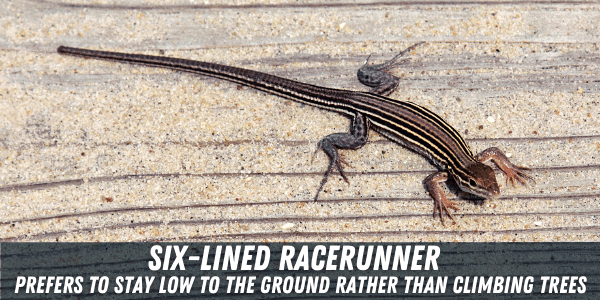
This lizard is appropriately named because of its six signature yellow lines that streak down its body. Behind the stripes is their main body color, which is normally dark brown.
For a small lizard, they are pretty quick on their feet and can easily reach up to 18 mph to grab a quick meal or to get away from a possible threat. Other than noticing their impressive speed, you can also identify this lizard by looking at their tails, and how they look to be larger than they need to be.
Where To Find The Six-Lined Racerunner in Florida
In Florida, you will most commonly find Six Lined Racerunners sticking around open habitats and dry areas like dunes, woodlands, and scrubs. This gives them plenty of room to scurry around looking for their daily meals.
The six-lined racerunner is known to be more terrestrial, meaning that they prefer to say low to the ground rather than climbing up trees like other lizards like to do.
What Does The Six-Lined RaceRunner Eat in Florida
These lizards main diet in Florida consists of insects, much like any other lizard species. Since this species is rather small in size, they can’t eat a whole cricket or grasshopper, so they stick to smaller bugs like spiders and other small invertebrates.
Florida Scrub Lizard
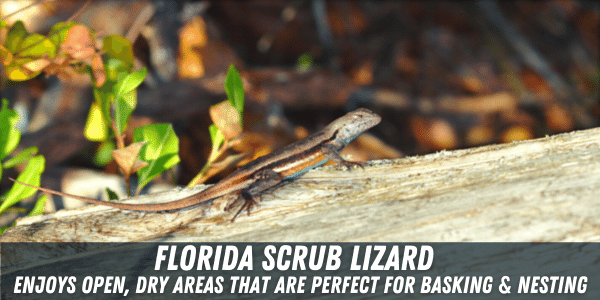
This lizard is quite small in size, only growing to about 5 inches in length at the longest, and this includes the tail too. Normally, Florida Scrub Lizard will appear to be brown or gray in color and they will always have the two brown striped going down either side of its body.
You can tell apart a female and a male scrub lizard apart by looking at markings on specific parts of their bodies. The male lizards tend to have blueish or turquoise patterns on their bellies and on their throats and chins.
Females lack these turquoise markings, but will have lighter patches on their abdomens occasionally.
Where To Find The Florida Scrub Lizard
Their name is actually based off of their natural habitat, which is the Florida scrub! This also includes the sand pine scrub and evergreen oak.
Similar to other lizards, the Florida scrub lizards enjoy open, dry areas that are perfect for basking and nesting as well. They will normally bask and nest close to the sand pine scrub and evergreen oak as forms of shelter from potential threats.
What Does The Florida Scrub Lizard Eat
Like some other species of reptiles, the Florida scrub lizard will use the “sit and wait” method when it comes to catching their prey. Since they are a much smaller species of lizard, they are not able to eat larger insects like grasshoppers and locusts.
Instead, these smaller lizards will eat a variety of small insects consisting of ants, spiders and beetles.
Eastern Glass Lizard
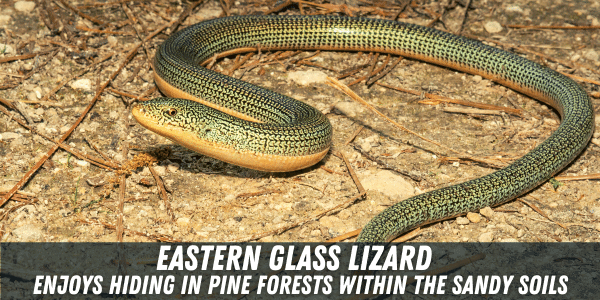
At first glance, you might think you are looking at a weirdly shaped snake, when it isn’t a snake at all! It’s actually the legless eastern glass lizard that can be found in Florida.
This lizard can grow to around 42 inches in length and they can come in a variety of colors, consisting of green, brown, tan, and some will even appear to have a bluish shine to them.
You will often see them decorated with dozens of little, white spots all around their faces and bodies. Juveniles tend to have tan-colored bodies with two dark stripes that run down both sides of their back.
Where To Find The Eastern Glass Lizard In Florida
The eastern glass lizard can most commonly be found around the southernmost parts of Florida, but they can generally be found throughout the entire state of Florida as well as the majority of the Southeast.
These legless lizards enjoy hiding in pine forests within the sandy soils. You can also find them in mixed hardwood on occasion, although it wouldn’t be their first choice in places to hide.
What Does The Eastern Glass Lizard Eat
Since these legless lizards tend to grow big in size, they are able to eat anything from large insects to small mice.
Even though this species may resemble the common snake, they are still not able to unhinge their jaw in order to consume a larger meal. This limits what the lizard is able to eat everyday.
Florida Sand Skink
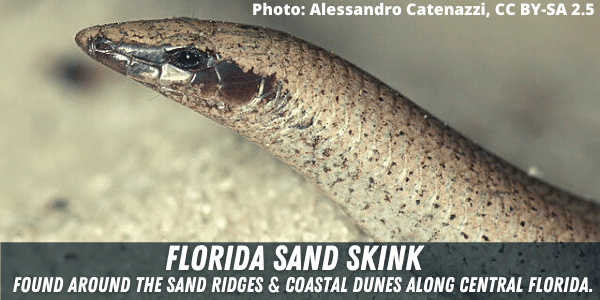
Florida Sand Skink can only grow to be about 5 inches long, and they are well-known for there long, seemingly legless bodies. They tend to come gray in color, but some also come in a light brown color as well.
These lizards actually do have legs, but they are so tiny that you can barely even see them! They are also known to have small eyes and a wedge-shaped nose with no visible openings.
Where To Find The Florida Sand Skink
The Florida Sank Skink can most commonly be found around the sand ridges and coastal dunes along Central Florida. Oak scrubs and rosemary scrubs can be found in these habitats, and you might find these little lizards scurrying around in them.
They are only found within seven counties in the state of Florida. Those counties are Marion, Putnam, Orange, Lake, Highlands, Polk, and Osceola.
What Does the Florida Sand Skink Eat?
Since this is a smaller species of lizard, they are only able to eat smaller insects. These insects can consist of spiders, beetles, termites, larvae, and a variety of other small bugs.
Although, this lizard’s favorite meal tends to be the ant lion, which is a small insect that somewhat resembles a common dragonfly.
Eastern Fence Lizard
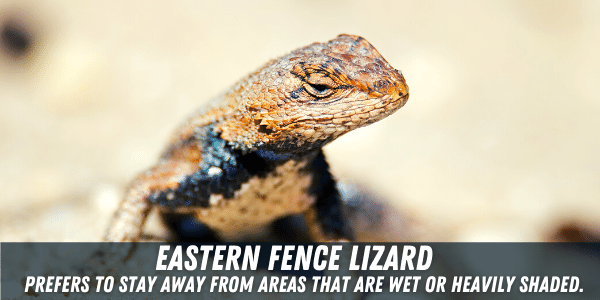
This smaller species of lizard usually can only grow anywhere from 4 to 7 inches long by the time they reach adulthood and they normally come in different shades of gray and brown with a dark stripe running along the backs of their thighs.
You can tell a male and female eastern fence lizard apart simply by looking at the differences in their colors.
A male eastern fence lizard will normally look brown in color and during the summer, they will have a turquoise and black hue on the sides of their belly and throat.
The female will instead be more of a gray color with a series of little dark stripes running all the way down her body.
Where To Find The Eastern Fence Lizard In Florida
You can find eastern fence lizards anywhere on the eastern end of the United States, from southern New York all the way to the northern Florida.
The eastern fence lizards tend to enjoy dry, open areas like woodlands, hardwoods, and pines and they prefer to stay away from areas that are wet or heavily shaded.
This lizard is also well-known to be arboreal, which means that they enjoy dwelling on or around trees, logs, stumps, and rocks too.
What Does The Eastern Fence Lizard Eat
The eastern fence lizard is known to go out and hunt for its food at least twice everyday. Normally in Florida, they will hunt and eat a variety of insects consisting of stinks bugs, grasshoppers, crickets, spiders, and even moths if they can get one.
The female lizards will normally eat more insects than the males around spring so they will be able to conserve plenty of energy to lay eggs.
Nile Monitor
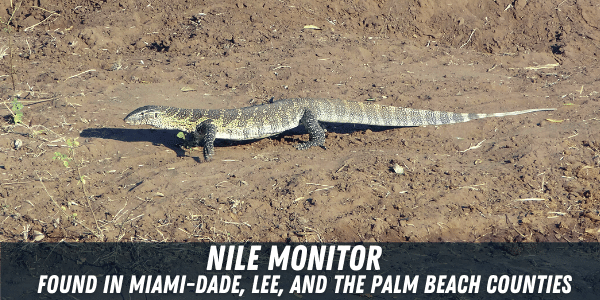
The nile monitor is certainly one of the larger lizards that will be covered in this list. These lizards can normally grow up to 5 or 6 feet in length and will usually weigh around 17 to 18 lbs.
The nile monitor will usually have an olive green or black color to them, and their bodies are decorated with either cream or yellow-colored stripes on the sides of its head as well as its jaw.
They will also have yellow stripes that go from the base of their heads and necks, which then transform into the stripes you will see on their backs.
Their tail is quite long, around 1.5 the length of its body, and it will be shaped similar to a rudder. This will aid the nile monitor in swimming to either catch food or get away from any predators.
Where To Find The Nile Monitor In Florida
The nile monitor is actually native to Africa throughout the Nile River delta, hence their name.
Although, when in Florida, you will most likely find these lizards in within certain counties in the southern parts of Florida, such as Miami-Dade, Lee, and the Palm Beach counties.
Like any other lizard, the nile monitor loves to bask in the sunshine on top of rocks and branches. They can also be seen basking close to bodies of water so they can have a quick escape if it’s needed.
What Does The Nile Monitor Eat
This lizard has an incredibly broad diet and you will find it hunting just about anywhere. You can most commonly find them hunting for their next meal in both fresh and salt water.
The nile monitor in Florida will anything from smalls crabs, snails, fish, and frogs, but they will also consume insects, turtles, snakes, birds, and even their eggs if they had any.
Green Iguana
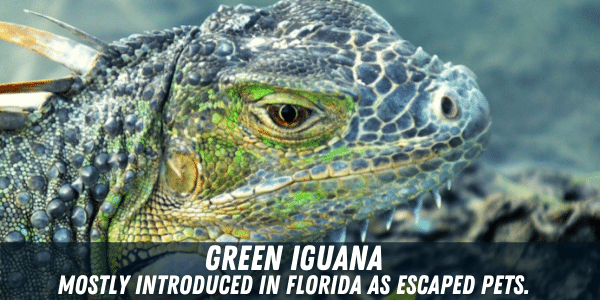
The green iguana is not only found inside of glass terrariums in pet stores, they can also be found in the wild in Florida. They will normally be a dull green or gray color with dark bands around its tail.
You will also find spines on top of their head and going down their back to the base of their tail. A juvenile will commonly have a bright green color to them.
A male green iguana can grow up to 5 feet in length and can weigh around 17lbs. A female is also able to grow to 5 feet, but they rare ever surpass 7lbs.
Something that makes these lizards unique is the fan on their throats, which is called the dewlap. They will move this little fan either as a way of saying hello to other lizards or if they are feeling territorial.
Where To Find The Green Iguana In Florida
The green iguana was introduced to Florida when people started keeping them as pets in captivity. Since then, plenty have either escaped or have simply been set free into the Florida wilderness.
This had led them to be able to breed in certain counties in Florida. These counties consist mostly of southern Florida counties, such as the Miami-Dade and Palm Beach counties.
The green iguana is known to hide in burrows in the right environment. Other times, you will be able to find them residing in drainage pipes or under debris piles.
What Does The Green Iguana Lizard Eat
These lizards absolutely love to snack on vegetation, especially the pretty type that you like to decorate your homes and yards with!
These plants consist of fan palms, roses, orchids, jasmine, nickerbean, and firebush. They also like snacking on vegetation from your gardens as well, such as melons, squash, and collared greens.
The green iguana in Florida won’t only consume vegetation though. It Is also known to feast on bird eggs and dead animals if they happen to find any. A juvenile green iguana will normally eat small insects, snails, and vegetation.
Spiney-Tailed Iguana
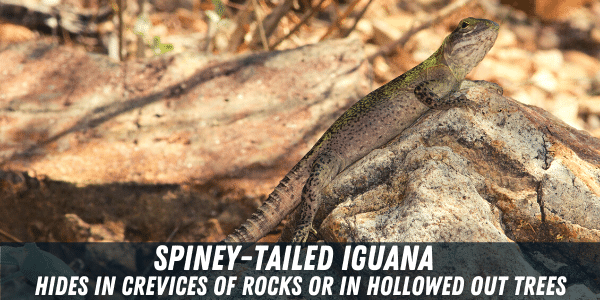
These lizards normally have a grayish color to them with dark colored bands that go around its midsection. The only noticeable difference between the males and females would be the absence of spikes on the females.
Male spiney-tailed iguanas tend to have a row of spines that go all the way down its back and tail, while the females will lack this trait.
Where To Find The Spiney-Tailed Iguana In Florida
These lizards are known to be semi-arboreal, which means that they spend some time up in the trees, and other times they will be on the ground.
Whenever they decide to spend time on the ground, you will normally find them in the crevices of rocks or in hollowed out trees in Florida.
If you happen to live in the southern part of Florida, then you should be able to easily find one in the wild. They are considered to be an invasive species in Florida, as they were originally distributed from Central America.
What Does The Spiney-Tailed Iguana Eat
Spiney-tailed iguanas will primarily eat plants and other greens, such as flowers and sweet fruits. If they are able to find them, then the iguana will go for small animals and their eggs, if they happen to find some close by.
Juvenile spiney-tailed iguanas tend to feast on insects until they start to grow out of their usual diet and will start to eat more plants and small animals like the adults.
Giant Argentine Tegu
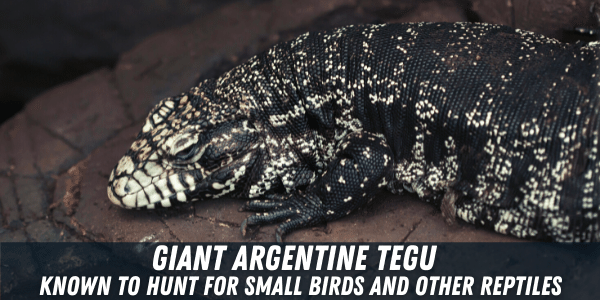
These lizards will normally reach about 4ft in length once they are fully grown and their scaly skin will be a gray or red color, with dark bands going around its midsection.
Its body will also be decorated with a vast amount of black and white spots, most of them being found along their face, neck, and legs. Juveniles will often have a brighter green color to them and the tips of their tails will have yellow and black bands. When they grow older, the yellow will change into speckles.
Where To Find The Giant Argentine Tegu In Florida
The giant Argentine tegu is native to Argentina, but were then brought to the United States for the purpose of selling them as exotic pets. Since then, tegus have either escaped from their enclosures or they were set free by their owners to live in the Florida wilderness.
In Florida, these larger lizards have mostly been found in the Hillsborough and Miami-Dale counties, both of which are located in southern Florida. Hillsborough county is located on the southwestern side of Florida.
You will often find adult tegus on the ground either basking or hunting for their food, while young tegus can be seen from the trees, where they will be hiding from potential threats.
The adults that are on the ground can normally be found in marshes, while in the winter months, they will be hibernating in their burrows until around February.
What Does The Giant Argentine Tegu Eat
The giant Argentine tegu has a large range of foods it regularly likes to eat. In Florida, these foods range all the way from insects to to small animals even other reptiles like lizards and snakes.
You can also find them eating some sweet fruits along with their seeds if they end up finding any nearby. When they are hunting for small birds or other reptiles to eat, they will also make sure to eat any of the eggs they may have left behind as well.
Ground Skink
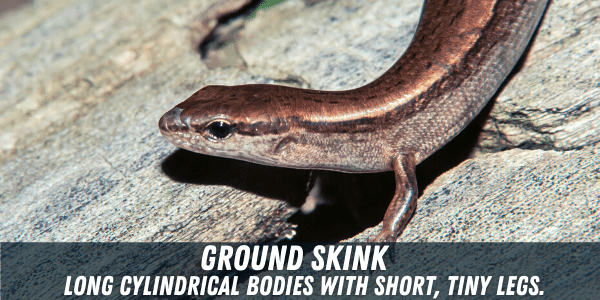
This species is known to be the smallest within the large family of lizards, and you can easily identify them by looking at their long, cylindrical bodies and their short, tiny legs.
Their skin will have a copper or a brown color to it with a darker stripe running all the way down its body on each side of its back.
Where To Find The Ground Skink In Florida
You are able to find this lizard throughout the entirely of the state of Florida except for in the south-central wetlands. The ground skink prefers environments with loose soil and plenty of leaf coverage for protection from predators.
The ground skink prefers loose soil for the purpose of “swimming” through it, since they can’t exactly dig burrows or climb up trees.
What Does The Ground Skink Eat
Because of their small size, the ground skink will tend to prey on small insects and spiders along with a variety of other small invertebrates.
Slender Glass Lizard
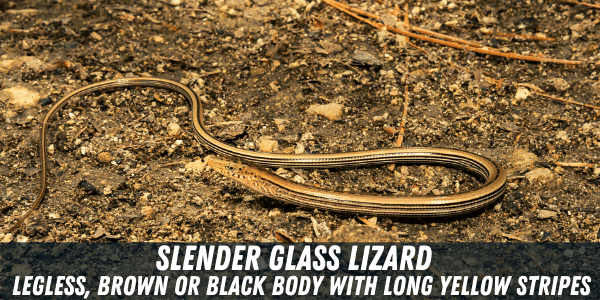
Ranging at about 42 inches in length, the slender glass lizard is another species of legless lizards that has a brown or black body with long, yellow stripes that go all the way down the length of its body.
You will almost think it is a snake at first glance, but there are a few noticeable differences that they have compared to snakes. The slender glass lizard is able to move their eyelids and their external ear openings.
They also have inflexible jaws, so they limits the size of their meals.
Where To Find The Slender Glass Lizard In Florida
You can find slender glass lizards just about anywhere in Florida except for the south-central wetlands. This is because the slender glass lizard highly prefers dry, sandy coasts. So you might end up finding more close to the beaches.
Occasionally, you will also be able to find them away from the coast and hiding in longleaf pine forests or even in human-made debris, which can also be a popular hiding spot.
What Does The Slender Glass Lizard Eat
The slender glass lizard consumes a large variety of insects, consisting of grasshoppers, spiders, beetles, cricket, and small snails. In Florida, they will also eat small rodents or other small lizards and snakes depending on their size.
Since these lizards do not have inflexible jaws, they are limited in what they are able to eat, normally sticking with smaller meals so they won’t choke.
Mimic Glass Lizard
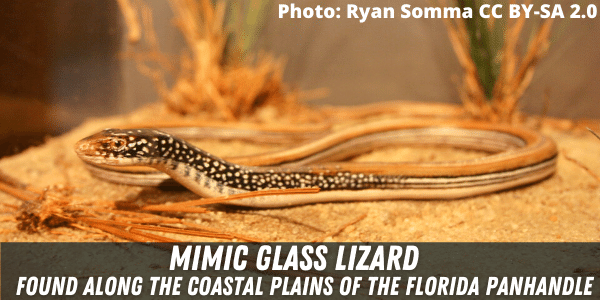
This is yet another species of lizard that can be mistaken for a small snake because of it being legless. This lizard normally appears bronze in color with black and yellow speckles and stripes decorating its body.
Unlike a snake and very much like other lizards, it is able to move its eyelids and it is also has an inflexible jaw, meaning it can’t eat larger meals like a snake would.
It can grow anywhere from 15 to 26 inches in length, so it is smaller than other glass lizards. Males tend to grow larger than the females and they also seem to be more active as well.
Where To Find The Mimic Glass Lizard In Florida
You will most likely find these lizards along the coastal plains of the Florida Panhandle. You can also find them within the open woodlands and in the pine flatwoods.
This is the only species of lizard that you can only find in the Florida Panhandle.
What Does The Mimic Glass Lizard Eat
The mimic glass lizard’s diet is poorly understood by most, but it is most commonly known to eat a variety of small insects and invertebrate.
These insects consist of small spiders, snails, and occasionally a cricket or grasshopper depending on their sizes. Since this lizard is small with an inflexible jaw, it’s important for it to eat smaller meals so it won’t hurt itself.
Broadhead Skink
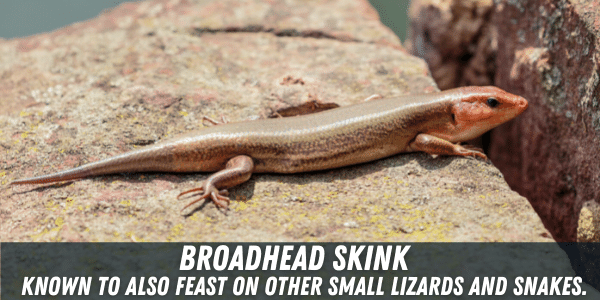
Growing to around 13 inches, the Broadhead skink is known to be one of the largest species of skinks, right next to the glass lizards.
Normally, their bodies will be either brown, black, or gray in color with around 5 yellow or white stripes that run down the length of its body. A juvenile will tend to look darker in color with a bright blue tail tip. Their color will fade to a brown or gray as they grow older and their blue tails will fade as well.
Where Can You Find The Broadhead Skink In Florida
This species of lizard can be found throughout the majority of northern and central Florida in the woodland areas and forests.
The broadhead skink is a tree-dwelling species, so you will almost always find them up in the trees where they will be basking in the sun on an exposed branch. When threatened, these lizards will immediately run up the nearest tree.
Juveniles will most commonly be found on the ground on fallen trees and hiding under the bark or other debris.
What Does The Broadhead Skink Eat
Like many other lizards, the broadhead skink will hunt for insects and spiders to feast on. The larger skinks are normally able to overpower any invertebrate they want to eat because of their powerful jaws.
In Florida their diet isn’t only limited to insects though, as this lizard has also been known to occasionally feast on other small lizards and snakes.
Island Glass Lizard
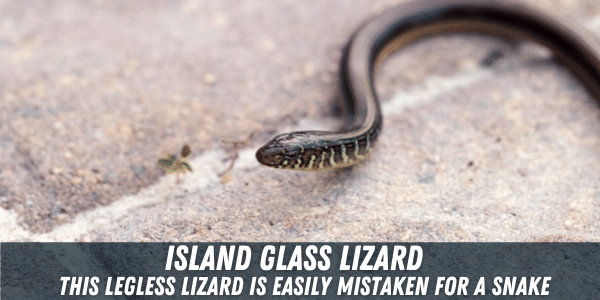
The island glass lizard is another one of the legless lizard species that can be found in Florida. It can be easy to mistake this lizard for a snake, but unlike the snake, the island glass lizard is able to move its eyelids and it has an inflexible jaw.
This species usually have tan bodies with a dark stripe going down either side of its back. The sides of its face will also be decorated in plenty of yellow and white speckles.
Where Can You Find The Island Glass Lizard In Florida
These legless lizards can easily be found all throughout Florida except for in the southcentral wetlands. This lizard normally prefers a drier habitat to thrive in and you will be able to find them in a lot of sandy scrub environments.
Offshore islands will normally have some of these lizards slithering around as well.
You can most often find the island glass lizard hunting for food by day, most commonly around the early evening. They prefer open habitats for hunting in and you can find some hiding under debris and boards from potential predators.
What Does The Island Glass Lizard Eat
Unlike snakes, the island glass lizard does not have a flexible jaw, which means that they are unable to eat larger meals without hurting themselves. These meals will often include a variety of insects and other invertebrate, such as spiders, grasshoppers, and beetles.
Poison & Dangerous Lizards In Florida
Here is a short list of a few of the dangerous/venomous lizards in Florida currently:
- Green Iguana
- Crocodile Monitor
- Water Monitor
- Gila monster
How To Catch Lizards In Florida
The majority of these lizards, especially the small ones, are completely harmless, so if you manage to find one in your home, you can simply place a cup or a bowl over it like you would do a spider, and release back outside.
If you prefer to set up traps to catch the lizards, you can set out small pieces of fruit or vegetables as bait. These little treats will normally be enough to attract them close enough to capture them in the trap.
Small bugs like crickets or spiders will also do the trick.
If you are planning on catching them with your hands in the wild, there is an easy and gentle way to handle these lizards without hurting them. Simply place your hand over the lizard you want to catch and gently rest your index finger on the top of its head.
This gentle and simple action is enough for them to remain motionless in your hand.
Do Florida Lizards Lay Eggs?
Yes! The vast of majority of lizards that inhabit Florida are generally egg-laying, so you should be able to find nests in the wild if you know where to look. Although, other species of lizards have been known to birth live young as well.
Lizards In Florida That Are Known To Come In House
There are not many lizards that have a strong desire to enter your home, and the majority actually manage to get in purely by accident.
In Florida, the brown anole can be most often found in your home, usually ending up there by accident. Iguanas have also been known to wander into people’s houses, giving the residents quite the surprise.
If you live in either urban or suburban, there is no escaping these lizards in Florida. The warm climate mixed with a rich environment and plenty of bright porch lights will surely attract a lizard or two to your home.
How Do I Get Rid Of Lizards In Florida
There are plenty of quick, cheap, and easy ways you can get rid of and also prevent lizards from getting into your home. Most of the ingredients you will need are actually in your kitchen cabinets!
Eggshells, surprisingly, are a natural reptile repellant. Place the eggshells anywhere you have seen lizards in your home.
Pepper spray and other strong scents like hot sauce and cayenne can also be sprayed anywhere you have been seeing the lizards.
Dispose of leftover food, as reptiles will occasionally be attracted to the smell, and seal up any cracks in your home.
If you don’t feel like mixing anything up at home, then lizard repellant sprays are available at almost any supermarket.
Mothballs are a great method for getting rid of lizards in your home. Lizards hate the smell of mothballs, so it will naturally repel them.

